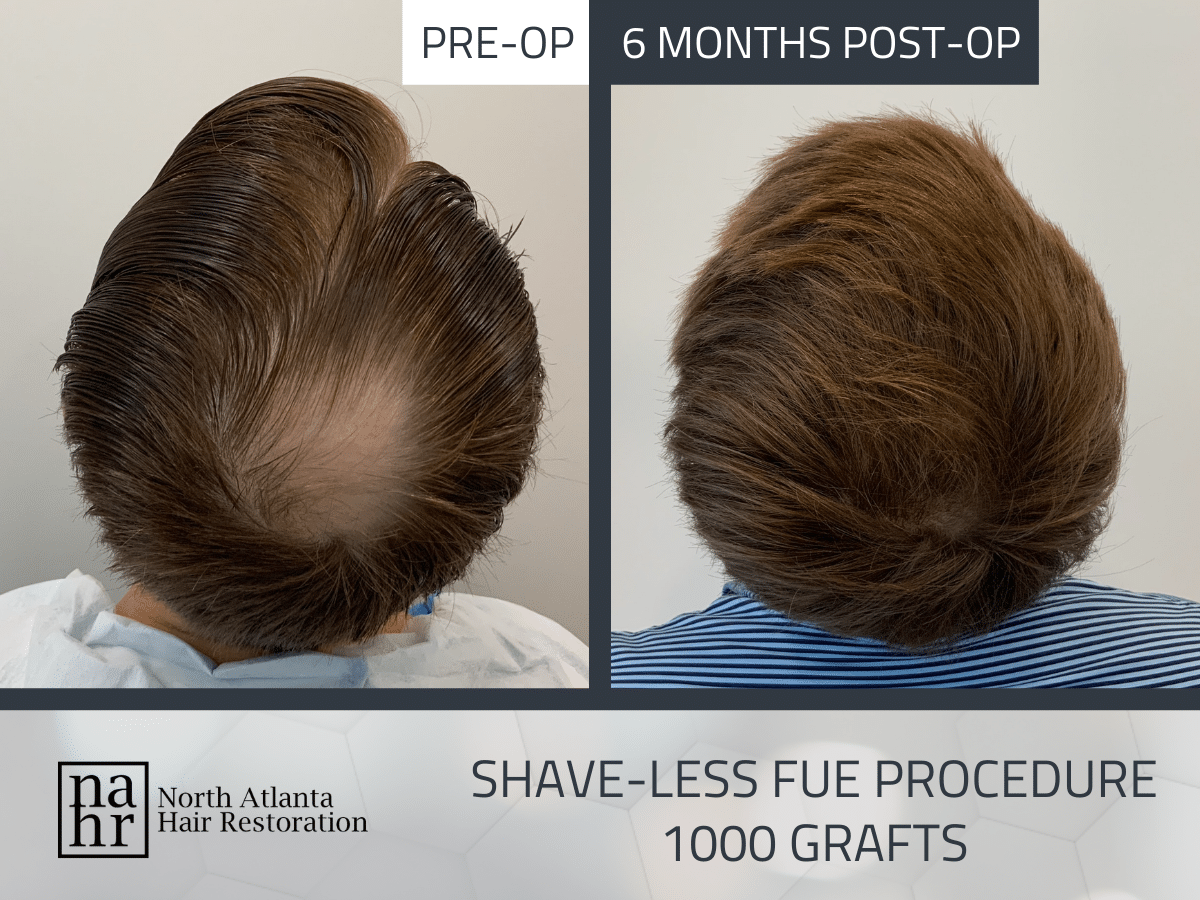If you’ve been researching surgical hair restoration options, you may have stumbled on mentions of something called the DHI technique.
There are a lot of technical terms surrounding hair transplantation to make sense of—lots of acronyms!—so let’s start by defining a few of them before we get down to what makes DHI worth knowing about.

Different Types of Hair Transplants
- FUT: Stands for Follicular Unit Transplantation. This was the older method used for hair transplants. Also known as strip transplantation, it involves taking strips of hair and transplanting them to thinning areas. Known for leaving unsightly scars, it has a tendency to look unnatural.
- FUE: Follicular Unit Excision. This modern method involves extracting individual hair follicles, which contain 1-4 hairs apiece, then transplanting the grafts into desired areas of growth. The grafts are placed into tiny incisions the surgeon makes individually.
- Shave-Less FUE: Also known as No-Shave, this variation on FUE doesn’t require shaving the donor areas, so you can keep your regular hairstyle largely intact for discretion.
- Long Hair FUE: Transplants the hair grafts at full or close-to-full length for even greater concealment and discretion. Also known as Preview FUE because it gives you a sneak peek at how your final results will look once they grow in permanently.
- Beard and Body Hair FUE: Uses the beard or other parts of the body as a donor area for hair follicles—usually used when donor sites on the head are already depleted.
What is DHI, and What Makes it Unique?
DHI is an advanced type of FUE that offers many advantages for patients.
The letters stand for Direct Hair Implantation, and it’s called that because the hairs are implanted directly into the scalp using a special implanter pen.
How does DHI differ from regular FUE?
DHI differs from traditional FUE in that the doctor uses a specialized implanter pen to both create the recipient site and place the graft in one motion. In standard FUE, the doctor makes the incisions first, and then technicians insert the grafts into those sites.
That may not seem like much of a difference, but it is actually a huge advancement.
Considering that most hair transplants range from 500-2000 grafts or even more, that’s hundreds or thousands of tiny steps saved—for greater speed and efficiency.
The greater efficiency also makes it possible to transplant more grafts in a single session.
What’s more, it means that the grafts endure less handling, giving DHI one of the highest follicle viability rates of any type of transplant.
That translates to thicker hair and better coverage, with fewer wasted grafts.
If you don’t have a lot of good donor sites left—or want to preserve what you have for future transplant needs, every follicle is precious.
But those aren’t even the best things about DHI, although they do contribute to making it the hair transplantation method of choice for many.
No, the biggest advantage of DHI lies in how good the results can look.
DHI Can Produce Incredibly Natural-Looking Results
Speed, efficiency, and follicle survival rates are nice, but what most patients really want is to come out looking like they have a truly natural-looking head of hair.
We’ve all seen hair transplants that looked like, well, a bad hair transplant, with that doll hair look, a weird texture, or hair growing in unnatural directions.
Luckily today, in the hands of a skilled surgeon, FUE hair transplants can produce impressively natural results.
DHI ups the ante on that, with even more precision and placement control.
The high tech DHI pen allows the surgeon to perfectly control the position, direction, angle, and depth of every graft.
That means the hairs can be placed precisely where they need to go, and it helps ensure that they grow at the correct angle and direction.
Plus, the surgeon can more easily see progress during the procedure, and adapt quickly to fill in areas or change angles for better textural growth.
The reason DHI is such a sought-after procedure by those in the know is that it allows for such incredible artistry in follicle placement.
The result when it’s done right: superior blending and hair that looks like it’s been growing there naturally forever, all on its own.
“Yes, it does work. Yes, it’s long-term, and yes, it can be very empowering and life-changing”
— Dr. Daniel A. Danyo
Not All Surgeons Specialize in DHI
As with any advanced hair restoration technique, it takes a highly skilled practitioner to get the best results.
So be sure to choose a hair restoration surgeon who is experienced in the DHI technique.
Ask questions, read reviews, and check out before and after pictures to see what typical end results look like.
A personal consultation will help you vet providers and find out which hair restoration options might be right for you.
Interested in What DHI Can Do for You?
North Atlanta Hair Restoration specializes in DHI hair transplants, and our practice provides unparallelled care at every step.
Dr. Daniel A. Danyo, Dr. Matt Goldstein and their medical team are experienced in the latest, most innovative techniques, and they are always working to improve and expand what’s possible for patients.
Don’t wait to find out what sets us apart from the rest – call today at 678-845-7521 to set up a personalized consultation, or click here to book one online.
FAQ
Does DHI work on all types of hair?
DHI works on a variety of hair types, including curly, wavy, and ethnic hair textures.
However, only a hair restoration expert can assess your individual situation and recommend the right hair loss treatment for you.
Is DHI better than FUE?
Many experts consider DHI superior to regular FUE in terms of speed, transplant success, and overall aesthetics.
Of course, who’s doing your transplant matters a lot, too, so be sure to choose an experienced provider, no matter what kind of hair restoration you choose.
Is DHI a good choice for women?
DHI can produce great results for women facing hair loss.
Female hair restorations using DHI are highly aesthetic and natural-looking—an absolute must for our discerning female clients.
As always, an in-person consultation is necessary to get the best recommendations, so make an appointment today and take the next step to a more confident, happy you!


